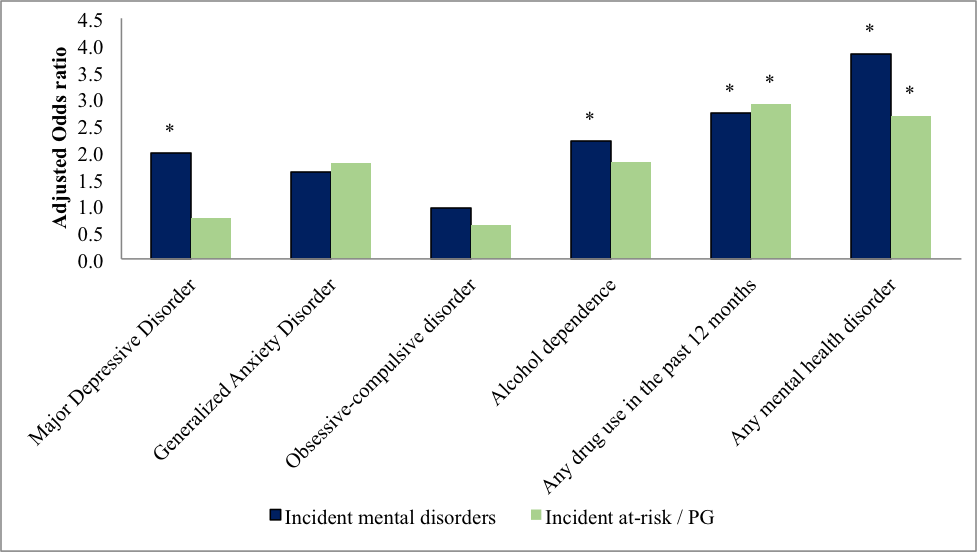The perils of gambling-related problems and mental health/substance use disorders are diverse. By now, researchers have also come to understand that the two are frequent companions, and often unleash their destructive forces in tandem. To better understand the complicated relationship between co-occurring gambling-related problems and other mental health issues, researchers need to establish how these problems develop over time. In doing so, they will better understand how some mental health problems create risk for others. The BASIS, this week, reviews a study by Dr. Tracie Afifi and colleagues that uses data from young adults captured over several years to explore this research question. This review is part of our Special Series on Gambling Disorder.
What was the research question?
Among people who struggle with more than one disorder, do gambling-related problems or other mental health problems typically develop first?
What did the researchers do?
Afifi and her colleagues analyzed data from the Manitoba Longitudinal Study of Young Adults (MLSYA), which surveyed 679 young adults (aged 18 to 20) every year from 2007 to 2011. Based on their behavior within the past year, participants reported upon their gambling-related problems, whether they had any mental disorders, any substance use disorders, and/or problems with illegal drug use. In addition, the survey also asked participants about their social and demographic characteristics. The researchers completed longitudinal logistic regression analyses to examine patterns in the data. They were especially interested in incident development, which looks at how occurrence of a condition in a population unfolds over a given time.
What did they find?
Young adults who reported having gambling-related problems at the start of the survey were, over the subsequent years, more likely to develop major depressive disorder, alcohol dependence, any drug use problems, and any mental health disorder than their counterparts who were non-gamblers or non-problem gamblers. Conversely, those who reported having any drug use or any mental health disorder were more likely to develop problems with gambling than those who did not. The study also found that, in comparison to respondents who did not use illegal drugs, young adults who indicated that they used illegal drugs at the start of the survey were more likely to be categorized as having gambling-related problems in the subsequent years.
Why do these findings matter?
Healthcare professionals working with young adults will benefit from incorporating the insights from the study into their practice as it informs their understanding of how past behavior of young adults expose them to additional risk factors. The study provides preliminary evidence that the medical condition and behavior of young adults aged 18 to 20 can have a direct bearing on their risk for other behaviors and conditions when they are 23 to 25 years old. As the study provides evidence that reducing the prevalence of one disorder will have a complementary effect on other disorders, from a public health perspective, the findings indicate that the return on investment for programs that target risky gambling, mental health disorders, and illegal drug use are higher than previously estimated. The findings also suggest that the most effective prevention strategies are those that target both problem gambling and mental health/substance use disorders. For instance, when Massachusetts expanded its gambling opportunities, public health workers recognized the potential increase in substance use disorders and other health conditions and proactively developed a plan to strengthen the capacity of providers who treat these conditions.

Figure. Estimates of odds ratio, adjusted for social and demographic variables, for at-risk or problem gamblers relative to non-gamblers and non-problem gamblers. Adapted from Afifi et.al. (2016). Bars with * above them represent variables that are statistically significant. Click image to enlarge.
Every study has limitations. What are the limitations in this study?
As the study strives to shed light on young adults (18 to 20 years olds) who suffer from certain mental health disorders, whether the findings would hold true for a different age group and when considering a richer set of mental disorders (for example, panic disorder, bipolar disorder) is beyond the scope of the study.
For more information:
For help with finding substance use treatment please click here to visit the Substance Abuse and Mental Health Services (SAMHSA) webpage.
— Pradeep Singh
What do you think? Please use the comment link below to provide feedback on this article.





Rohini March 22, 2017
Is the high risk correlation between these conditions due to the mechanisms of the reward pathways and impulse control mechanisms associated with addiction and mental illness?
Pradeep Singh March 23, 2017
Dear Rohini: Thank you for your question. The precise behavioral mechanisms that are associated with both problem gambling and mental health disorders (which is a multi-faceted concept) is a growing research field, where a lot still needs to be learned. Some researchers have indeed found that mental health disorders like depression and problem gambling share the same underlying feature of impulsivity.
–Pradeep Singh